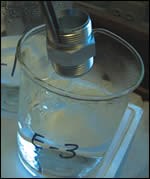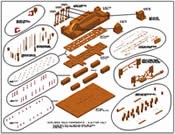ELV, WEE, RoHS and Hex-Chrome Testing
What you need to know about testing your plated parts
#pollutioncontrol
In the past few years many new acronyms have entered the English language. Three of these in particular—ELV and RoHS—have generated much hand-wringing in the metal finishing industry.
ELV stands for the End of Life Vehicle Directive (Directive 2000/53/EC). This is a European regulation aimed at eliminating as much automobile waste from landfills as possible. The basic idea is to disassemble and re-manufacture components of an automobile when it reaches the end of its useful life. To protect workers from toxic metals and compounds during this disassembly, the use of cadmium lead, mercury, and hexavalent chromium (along with certain other non-metallic compounds) is “banned.” The goal of this Directive is to have automobiles recycled at a level of 85 percent by the end of this year and 95 percent by 2015. Vintage and historic vehicles are exempted from the rule, but spare/replacement parts are included.
Featured Content
The word “banned” was in quotation marks above because the directive has a list of exemptions that include some parts that may continue to contain hexavalent chromium, for example, until suitable replacement coatings are found. A notable current exemption, for example, is for nuts/bolts used in the vehicle chassis. Such fasteners are exempt until July 1, 2008.
WEEE—Waste from Electrical and Electronic Equipment—is another European regulation (Directive 2002/96/EC). It requires all members of the European Community (EC) to pass regulations stating that electrical devices such as computers and household appliances be manufactured in such a manner that they can be recycled/recovered at a recovery rate of 70 to 80 percent based on the type of appliance.
RoHS (Restriction of Hazardous Substances in Electronic and Electrical Equipment; Directive 2002/95/EC) basically does for electronic equipment what ELV does for automobiles. To protect workers from toxic metals in these recycling operations, the inclusion of cadmium, lead, mercury and hexavalent chromium in electronic components of these devices is prohibited.
Global Impact
These European “bans” have generated a lot of confusion about the requirements for certifying that parts subject to the regulations are free of these metals.
While the above Directives apply only to European Community countries, global automobile and appliance manufacturers need to manufacture to only one standard. For this reason countless American manufacturers have sent out letters to metal finishers requiring that they “certify” that the coatings they are producing are RoHS- or ELV-compliant.
In response to such requests, metal finishers have been faced with only a few options: sign the certification, test the parts, or ignore the request. The third option will almost certainly cause the metal finisher to lose the customer. But what about the other two?
By signing the certification, the metal finisher takes on the responsibility for the coating being free of the banned substances. If, at any point in the future, the coating is found to contain excessive amounts of such banned substances, the metal finisher may be held liable for the cost of recall of the components.
Testing the parts provides a measure of confidence (and written “proof”) that the coating provided meets the ELV/RoHS requirements. The majority of metal finishers have opted to go this route if there is any question that the processing may incorporate a banned substance into the coating.
Where’s the Hex?
The list of coating types that are commonly produced in a manner that may introduce hexavalent chromium into the surface of an automotive or electrical component is long. It includes:
- Chromate conversion coatings on zinc, aluminum and magnesium
- Hard chromium plated deposits
- Decorative chromium plated deposits
- Black chromium plated deposits
- Passivation of 400-series stainless steel
- Chromic acid anodize coatings
- Sulfuric anodized aluminum (dichromate seal, dyes)
- Phosphate coatings (chromic acid seal)
- Stains on copper alloys
- Passivation of thermal sprayed coatings (post-treatment)
- Passivation of electroless nickel (post-treatment)
- Painting with chromate-containing primers and topcoats
- Anodic coatings on magnesium
- Chromate passivate films on copper, copper alloys, tin, and silver
- Passivation of trivalent chromium plate (post-treatment)
- Several proprietary alternates to plated coatings (for example, HVOF sprayed coatings post-treated in chromic acid).
A common question that needs to be answered right away is that chromium plated coatings (hard, decorative, or black) are not banned by any EC directive. The directive bans hexavalent chromium, which is a metal in the ionic state, while chromium electroplate is a metal in the atomic (not ionic) state. However, chromium plating can contain trapped hexavalent chromium from the plating solution (trapped in cracks and pores that are in the micro-structure of the deposit).
At Issue
None of the European directives or supplementary information includes procedures for testing parts to assure compliance. In response to this vacuum, most American manufacturers of automotive components have either produced their own specifications for testing parts for ELV compliance or have adopted specifications produced by others.
Compliance testing of coatings containing hexavalent chromium typically involves leaching parts in water followed by an analysis for hexavalent chromium in the leach water and a calculation of the amount (in micrograms per square centimeter, µg/cm2) of hexavalent chromium present on the surface. Under RoHS requirements, a coating may not contain more than 1000 parts per million (ppm) of mercury, lead or hexavalent chromium, and not more than 100 ppm of cadmium.
Unfortunately, ppm and µg/cm2 are not equivalent units. While some may say that compliance with ELV is equivalent to compliance with RoHS, tests conducted on parts may not necessarily agree. For example, a black chromium deposit may contain more than 2,000 ppm of hexavalent chromium (trapped in the metal coating), which would place the coating in violation of RoHS standards. A leach test of the same deposit may indicate compliance.
What is Actually Tested?
Another issue that needs some resolution is just what is to be actually tested for compliance, because there are coatings that are not readily amenable to the test. Under ELV, for example, a zinc plus chromate coating may be covered with a clear organic topcoat. Nearly any leach test for hexavalent chromium conducted on this coating will pass, unless the topcoat is removed before testing. Some specifications require that the top-coat be sliced off with a scalpel—not an easy thing to do on many parts. We believe that specifications need to be altered to require that chromated parts be tested in the absence of any subsequently applied coating.
There are no officially sanctioned procedures for testing electrical components for RoHS compliance. As a result, confusion is the order of the day, and laboratories are presently deciding how to proceed with little guidance. Unfortunately, this results in poor decision in some cases.
To fill the knowledge gap, some organizations have attempted to prescribe test procedures. The International Electrotechnical Commission (IEC; www.iec.ch), for example, has developed a document called “Procedure for the Determination of Levels of Regulated Substances in Electrotechnical Products.” One of the first steps in IEC’s recommended procedure for such determination is “mechanical sample preparation”—essentially, grinding up the entire sample into a fine dust before testing. While this may be acceptable in some select cases, in others the hexavalent chromium (or cadmium, lead, or mercury) content in the coating to be tested is diluted by the weight of the substrate. In cases where the electrical component consists of a substrate plus a plated metal layer, use of this type of sample preparation can yield test results that may come into question.
RoHS defines coatings to be tested as “homogenous” materials that can not be physically separated from the base material. It can be argued that any plated coating can be physically separated from the substrate. Plating adhesion is measured in pounds per square inch (psi), and if the coating’s adhesive strength is exceeded, it will be removed from the substrate. Therefore, the plating needs to be stripped off the substrate for RoHS compliance testing, and the substrate must not be included in the test sample.
Chromate coatings cannot be physically stripped off the plated substrate. So, by the RoHS definition, the chromate could be tested by stripping the chromate plus the zinc (or other plated metal) beneath the chromate film. However, this also creates a “dilution” false negative, as the weight of the zinc would be added to the sample weight used to make the Cr6+ calculation. Test results can then be manipulated by increasing the zinc deposit thickness.
Plethora of Procedures
Obviously, it would be beneficial to all concerned if a single procedure for testing of hex chrome content could be developed and agreed upon. Unfortunately, that’s not the case; multiple test procedures have been developed and promulgated by automotive OEMs, standards developers and other organizations. Some of these include:
- GMW3034
- Delphi DX900359/DX551300/DX51600
- ISO 3613
- ASTM D 5257/5281/6492
- Ford WSS-M1A343-A2/ ESF-M21P6
| Table I: Common Interferences with Diphenylcarbazide Method of Quantitation of Hexavalent Chromium |
|
| Positive Interferences | Negative Interferences |
| Presence of colorants (dyes) | Poor Extraction Efficiency |
| Turbidity | Presence of oil, wax |
| Hexavalent Molybdenum | |
| Mercury | |
| Vanadium | |
| Iron | |
| Copper | |
These testing procedures all have vagaries that can affect the results. Variations include procedures for sample storage time limits before testing, sample size, sample preparation prior to leaching (clean, don’t clean), leaching times, number of times parts are leached, rinsing procedures, verification that the leach process was complete, and method of quantitation (visual, spectrophotometer) of results. Many of these procedures have no provision for detecting and compensating for possible interferences, which are listed in the Table I.
Following is a brief, step-by-step description of one of these leaching procedures, GMW3034.
- Sample Preparation: Measure parts for surface area (50 sq cm desired for duplicate test run). This can be done from direct dimensional measurements, CAD drawings, or using math-based CAD models. Remove any topcoat with scalpel, add
particles to test water. - Boil part(s) in water for exactly five minutes and remove. Note that GMW3034 does not require a second boil to confirm leaching of all hex chrome; our laboratory suggests a second boil.
- Prepare calibration curve for colorimeter/spectrophotometer.
- Analyze using diphenylcarbazide indicator. Results can be determined using a spectrophotometer, a colorimeter or visually.
- Calculate and report hex chrome content in mg/sq cm.Concentration of <0.1 µg Cr+6/sq cm = pass.
In some cases, more exotic hex chrome detection methods, such as ion chromatography, may be necessary to verify the results obtained by the OEM procedure.
RELATED CONTENT
-
Choosing and Troubleshooting Copper Electroplating Processes
Learn more on this inexpensive and highly efficient process.
-
Blackening of Ferrous Metals
The reasons for installing an in-house cold blackening system are many and varied.
-
Plating Q&A: Can you color stainless steel?
Our expert, Art Kushner, says yes, you can color stainless steel, but it is not a process that is typically performed in a plating shop. Read more about his answer.






















